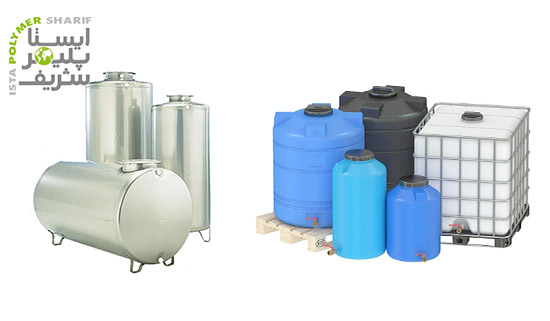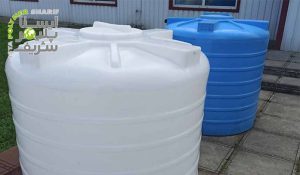Water holds a special importance in human life, and ensuring and maintaining it is something many people are seeking the best methods for every day. Storing water usually comes with many challenges because stagnant water quickly becomes algae-infested and its health deteriorates. Water tanks come in various materials so that you can keep water healthy depending on the conditions. In this article, we will examine two general types of water tanks: metal and plastic, and their advantages. By comparing each of them, we aim to help you choose the most suitable type.
Introduction to Metal and Plastic Water Tanks
It is better to get acquainted with the characteristics of metal and plastic water tanks before comparing them, and to understand the pros and cons of each type.
Metal Tank

Metal tanks are made from steel, stainless steel, or galvanized steel and can be used to store water, fuel, alcohol, etc. Galvanized tanks are suitable for storing water and have higher resistance to water compared to other metal tanks. These tanks are manufactured in various shapes such as vertical, horizontal, aerial, etc., depending on the conditions and installation site, to accommodate all users. Metal tanks are generally more expensive than plastic tanks due to their higher resistance.
Advantages of Metal Tanks
The high resistance of metal tanks means they are not damaged by sharp or cutting objects. Metal tanks can be produced in various sizes and volumes, allowing customers to obtain custom-sized tanks as needed. In specific locations or when dealing with large volumes, these tanks can be constructed on-site, eliminating installation challenges.
Disadvantages of Metal Tanks
Due to their high weight, metal tanks are difficult to move. Therefore, transporting and installing these tanks requires advanced equipment. Additionally, metal is not highly resistant to corrosive acids and may suffer from rusting, which can compromise water quality.
Plastic Water Tank

Plastic tanks are made from polyethylene materials, which makes them suitable for storing water and compatible substances. These tanks are widely available and used in various industries such as construction and agriculture. Like metal tanks, plastic tanks come in different models such as horizontal, vertical, cubic, under-stair, etc., to meet consumer needs in various conditions.
Advantages of Plastic Tanks
Plastic tanks are widely produced today, which means they are easily accessible in cities and regions. Additionally, the plastic material makes these tanks more cost-effective and lower in price compared to metal tanks. Due to their lightweight, plastic tanks are easy to transport and install with regular tools. Plastic tanks are resistant to corrosive substances and do not suffer from rusting. Some models are UV-resistant, which helps maintain water quality and extends the tank’s lifespan.
Disadvantages of Plastic Tanks
One of the disadvantages of plastic tanks is their vulnerability to damage. They can crack under strong impacts, and sunlight can reduce polyethylene’s resistance. However, this issue can be mitigated with UV-resistant additives, and most modern plastic tanks are UV-resistant.
Comparison of Metal and Plastic Water Tanks
Now that you are familiar with metal and plastic tanks, we will compare the factors to determine which is better: metal or plastic tanks.
Longevity
Plastic tanks typically have a lifespan of 15 to 25 years, depending on the brand and additives in the polymer. Generally, plastic tanks are suitable for atmospheric pressure conditions and may crack or be damaged by mechanical impacts. Metal tanks, on the other hand, are more resistant to sharp or cutting objects and usually have a lifespan of up to 25 years, provided the seams are properly welded and the coating remains intact. Metal tanks can suffer from corrosion if used for storing saline or chlorinated water, so they should be used for storing treated water to avoid rusting.
Water Quality
Plastic tanks for water storage are made from food-grade approved materials that prevent water contamination over time. The three-layer version of these tanks has UV-resistant properties that prevent bacterial and algal growth. Metal tanks, if produced with anti-rust properties and high-quality bolts, can also maintain water quality. Additionally, metal tanks reflect sunlight, preventing algae growth. However, the presence of bolts and rivets in metal tanks and the risk of rusting can still pose a threat to drinking water quality. Therefore, ensure the quality of these components when purchasing metal tanks.
Color and Design
The molding process of plastic tanks allows for production in various shapes to meet different conditions. For example, plastic tanks can be designed as under-stair, easy-access, oval, cubic, or truck-mounted types, each suited for specific spaces. Additionally, plastic tanks come in a wide range of colors. In contrast, metal water tanks are usually produced in vertical, horizontal, cubic, or conical shapes and are finished with an epoxy coating.
Capacity
Polyethylene tanks are generally produced in smaller capacities ranging from 100 to 30,000 liters and can store up to 50,000 gallons of water. Metal tanks can be produced in higher capacities and can be manufactured on-site for large volumes.
Conclusion
Metal and plastic water tanks are two commonly used types for water storage, each with different features depending on their material. In this article, we explored these tanks and their characteristics. The high resistance and large capacity of metal tanks, along with the lightweight and lower cost of plastic tanks, can make the choice difficult. The comparisons made in this article, along with existing conditions, can help you make a better decision on which type to choose.






